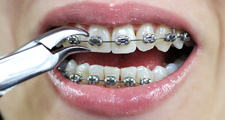
Treatment Phases
Most orthodontists follow a treatment plan that assumes adequate room is available or can be made available to avoid extraction of permanent teeth.
For Class I Malocclusion patients (patients with a normal bite/occlusion but crowded teeth), orthodontic treatment generally involves placing highly specific braces on all the upper and lower teeth (typically the upper braces to start treatment). Once the uppers are properly aligned, the lower braces are added though which wires are weaved.
The first six months of orthodontics treatment deal with disentangling the teeth and achieving symmetrical alignment of the right and left sides of the dental arches via small, flexible wires that exert low, steady force for one to four months. Alignment relies upon using space that is naturally accessible. In this stage, it is integral that any rotations of the teeth are corrected as rotations have the highest recidivism rate.
After teeth have been readied, the orthodontics dentist takes steps to vertically level the teeth by achieving normal curvature, paralleling teeth roots and matching the shape of the upper and lower arches. The braces must then be stabilized sometimes through additional use of elastics to correct the positions of certain teeth or the midlines. After the alignment of the teeth is considered stable (due to time and force), the braces are removed by the orthodontist and replaced with an orthodontic retainer.
Read on to learn more about specific phases of orthodontic treatment.


